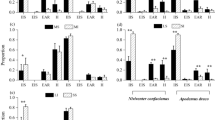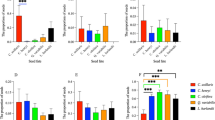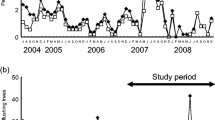Abstract
Conifer seeds are a component of the diet of many rodents, but it is not known whether these seeds can be used as a major food source by rodents. Investigating this is critical to understanding how individual rodents utilize conifer seeds, and how their populations interact with seed production by coniferous trees. We examined the effects of conifer seed-diets on survival, body condition, food consumption, and gut morphology of deer mice (Peromyscus maniculatus) and southern red-backed voles (Myodes gapperi) in the laboratory. Experiments were conducted for 14 days using control food (laboratory rodent chow) and lodgepole pine (Pinus contorta), white spruce (Picea glauca), and subalpine fir (Abies lasiocarpa) seeds. The nutritional compositions of these seeds were also analyzed. Subalpine fir seeds contained the lowest crude protein content and highest fibre content relative to the other seeds. 60% of voles fed subalpine fir seeds were euthanized prior to the end of the experiment after losing greater than 25% of their initial body mass, whereas all mice survived to the end of the experiment in each group. Body masses of mice fed subalpine fir seeds were lower than those fed control food early in the experiment, but they compensated for this by increasing seed intake over the remainder of the experiment. They also retained more digesta in the caecum, which could increase digestion efficiency of the low-quality seeds. On the other hand, voles did not compensate for the low quality of subalpine fir seeds behaviourally (food intake) or morphologically (gut dimensions), and decreased in body mass dramatically. They also decreased in body mass in the long-term on white spruce seed-diets. It is likely that plant secondary metabolites played a major role in the deterioration of body condition of voles fed subalpine fir and white spruce seeds. These results indicate that conifer seeds are a sufficient food resource for mice, but cannot be used by primarily herbivorous voles as a major/sole food source.
Similar content being viewed by others
References
Abbott, H.G., 1961. White pine seed consumption by small mammals. J. Forest. 59, 197–201.
Abbott, H.G., 1962. Tree seed preferences of mice and voles in the northeast. J. Forest. 60, 97–99.
Abbott, H.G., Quink, T.F., 1970. Ecology of eastern white pine seed caches made by small mammals. Ecology 51, 271–278.
Alexander, R.R., Shearer, R.C., Shepperd, W.D., 1990. Subalpine fir. In: Burns, R.M., Honkala, B.H. (Tech. coords.), Silvics of North America (Agriculture Handbook 654). US Department of Agriculture, Forest Service, Washington, DC, pp. 92–115.
Association of Official Analytical Chemists, 1990. Official Methods of Analysis of AOAC. Association of Official Analytical Chemists International, Washington, DC.
Bauce, E., Kumbasli, M., Van Frankenhuyzen, K., Carisey, N., 2006. Interactions among white spruce tannins, Bacillus thuringiensis subsp. kurstaki, and spruce budworm (Lepidoptera: Tortricidae), on larval survival, growth, and development. J. Econ. Entomol. 99, 2038–2047.
Belovsky, G.E., 1984. Herbivore optimal foraging: a comparative test of three models. Am. Nat. 124, 97–115.
Ben-David, M., McColl, C.J., Boonstra, R., Karels, T.J., 1999. 15N signatures do not reflect body condition in Arctic ground squirrels. Can. J. Zool. 77, 1373–1378.
Bennick, A., 2002. Interaction of plant polyphenols with salivary proteins. Crit. Rev. Oral. Biol. Med. 13, 184–196.
Bergeron, J.M., Jodoin, L., 1987. Defining “high-quality” food resources of herbivores: the case for meadow voles (Microtus pennsylvanicus). Oecologia 71, 510–517.
Boonstra, R., Hik, D., Singleton, G.R., Tinnikov, A., 1998. The impact of predator-induced stress on the snowshoe hare cycle. Ecol. Monogr. 79, 371–394.
Bozinovic, F., 1995. Nutritional energetics and digestive responses of an herbivorous rodent (Octodon degus) to different levels of dietary fiber. J. Mammal. 76, 627–637.
Bozinovic, F., Novoa, F.F., Sabat, P., 1997. Feeding and digestive fiber and tannins by an herbivorous rodent, Octodon degus (Rodentia: Caviomorpha). Comp. Biochem. Physiol. A 118, 625–630.
Cole, F.R., Batzli, G.O., 1979. Nutrition and population dynamics of the prairie vole, Microtus ochrogaster, in central Illinois. J. Anim. Ecol. 48, 455–469.
Delguidice, G.D., Seal, U.S., Mech, L.D., 1987. Effects of feeding and fasting on wolf blood and urine characteristics. J. Wildl. Manage. 51, 1–10.
del Valle, J.C., Busch, C., Mananes, A.A.L., 2006. Phenotypic plasticity in response to low quality diet in the South American omnivorous rodent Akodon azarae (Rodentia: Sigmodontinae). Comp. Biochem. Physiol. A 145, 397–405.
Derting, T.L., Bogue, B.A., 1993. Responses of the gut to moderate energy demands in a small herbivore (Microtus pennsylvanicus). J. Mammal. 74, 59–68.
Despain, D.G., 2001. Dispersal ecology of lodgepole pine (Pine contorta Dougl.) in its native environment as related to Swedish forestry. Forest Ecol. Manage. 141, 59–68.
Dietz, B.A., Hagerman, A.E., Barrett, G.W., 1994. Role of condensed tannin on salivary tannin-binding proteins, bioenergetics, and nitrogen digestibility in Microtus pennsylvanicus. J. Mammal. 75, 880–889.
Drozdz, A., 1966. Food habits and food supply of rodents in the beech forest. Acta Theriol. 11, 363–384.
Duchesne, L.C., Herr, D.G., Wetzel, S., Thompson, I.D., Reader, R., 2000. Effect of seed predation, shade and soil organic matter on the early establishment of eastern white pine and balsam fir seedlings. Forest. Chron. 76, 759–763.
Ellis, J.E., Wiens, J.A., Rodell, C.F., Anway, J.C., 1976. A conceptual model of diet selection as an ecosystem process. J. Theor. Biol. 60, 93–108.
Everett, R.L., Meeuwig, R.O., Stevens, R., 1978. Deer mouse preference for seeds of commonly planted species, indigenous weed seed, and sacrifice food. J. Range Manage. 31, 70–73.
Fitch, H.S., 1954. Seasonal acceptance of bait by small mammals. J. Mammal. 35, 39–47.
Freeland, W.J., Janzen, D.H., 1974. Strategies in herbivory by mammals: the role of plant secondary compounds. Am. Nat. 108, 269–289.
Freeland, W.J., Calcott, P.H., Anderson, L.R., 1984. Tannins and saponin: interaction in herbivore diets. Biochem. Syst. Ecol. 13, 189–193.
Green, D.A., Millar, J.S., 1987. Changes in gut dimensions and capacity of Peromyscus maniculatus relative to diet quality and energy needs. Can. J. Zool. 65, 2159–2162.
Gross, J.E., Wang, Z., Wunder, B.A., 1985. Effects of food quality and energy needs: changes in gut morphology and capacity of Microtus ochrogaster. J. Mammal. 66, 661–667.
Hagerman, K.E., Klucker, K.M., 1986. Tannin-protein interactions. In: Harborne, J., Middleton, E. (Eds.), Flavonoids in Biologyand Medicine: Biochemical, Pharmacological, and Structure-Activity Relationships. Liss, New York, pp. 67–76.
Hagerman, K.E., Robbins, C.T., 1993. Specificity of tannin-binding salivary proteins relative to diet selection by mammals. Can. J. Zool. 71, 628–633.
Harju, A., Tahvanainen, J., 1994. The effect of silver birch (Betual pendula) powder on physiological performance of field voles (Microtus agrestis). Ann. Zool. Fennici 31, 229–234.
Jameson, E.W., 1952. Food of deer mice, Peromyscus maniculatus and P. boylei, in the northern Sierra Nevada, California. J. Mammal. 33, 50–60.
Kelly, D., 1994. The evolutionary ecology of mast meeding. Trends Ecol. Evol. 9, 465–470.
Koteja, P., 1996. Limits to the energy budget in a rodent, Peromyscus maniculatus: does gut capacity set the limit? Physiol. Zool. 69, 994–1020.
Lee, W.B., Houston, D.C., 1995. The rate of change of gut anatomy in voles in relation to diet quality. J. Zool. 236, 341–345.
Lewis, C.E., Clark, T.W., Derting, T.L., 2001. Food selection by the white-footed mouse (Peromyscus leucopus) on the basis of energy and protein contents. Can. J. Zool. 79, 562–568.
Lindroth, R.L., Batzli, G.O., 1984. Plant phenolics as chemical defenses: effects of natural phenolics on survival and growth of prairie voles (Microtus ochrogaster). J. Chem. Ecol. 10, 229–244.
Lobo, N., Duong, M., Millar, J.S., 2009. Conifer-seed preferences of small mammals. Can. J. Zool. 87, 773–780.
Lovegrove, B.G., 2010. The allometry of rodent intestines. J. Comp. Physiol. B 180, 741–755.
Marquis, R.J., Batzli, G.O., 1989. Influence of chemical factors on palatability of forage to voles. J. Mammal. 70, 503–511.
Martell, A.M., 1979. Selection of conifer seeds by deer mice and red-backed voles. Can. J. Forest Res. 9, 201–204.
Martell, A.M., 1981. Food habits of southern red-backed voles (Clethrionomys gapperi) in northern Ontario. Can. Field-Nat. 95, 325–328.
Martell, A.M., Macaulay, A.L., 1981. Food habits of deer mice (Peromyscus maniculatus) in northern Ontario. Can. Field-Nat. 95, 319–324.
Maser, C., Trappe, J.M., Nussbaum, R.A., 1978. Fungal-small mammal interrelationships with emphasis on Oregon coniferous forests. Ecology 59, 799–809.
McAdam, A.G., Millar, J.S., 1999. Dietary protein constraint on age at maturity: an experimental test with wild deer mice. J. Anim. Ecol. 68, 733–740.
Millar, J.S., Innes, D.G., Loewen, V.A., 1985. Habitat use by non-hibernating small mammals of the Kananaskis Valley, Alberta. Can. Field-Nat. 99, 196–204.
Nespolo, R.F., Bacigalupe, L.D., Sabat, P., Bozinovic, F., 2002. Interplay among energy metabolism, organ mass and digestive enzyme activity in the mouse-opposum Thylamys elegans: the role of thermal acclimation. J. Exp. Biol. 205, 2697–2703.
Norrie, M.B., Millar, J.S., 1990. Food resources and reproduction in four microtine rodents. Can. J. Zool. 68, 641–650.
Penry, D.L., Jumars, P.A., 1987. Modeling animal guts as chemical reactors. Am. Nat. 129, 69–96.
Radvanyi, A., 1970. Small mammals and regeneration of white spruce forests in western Alberta. Ecology 51, 1102–1105.
Radvanyi, A., 1971. Lodgepole pine seed depredation by small mammals in western Alberta. Forest Sci. 17, 213–217.
Schieck, J.O., Millar, J.S., 1985. Alimentary track measurements as indicators of diets of small mammals. Mammalia 49, 93–104.
Schlesinger, W.H., 1975. Toxic foods and vole cycles: additional data. Am. Nat. 110, 315–317.
Schreiner, M., Bauer, E.M., Kollmann, J., 2000. Reducing predation of conifer seeds by clear cutting Rubus fruticosus agg. in two montane forest stands. Forest Ecol. Manage. 126, 281–290.
Seal, U.S., Hoskinson, R.L., 1978. Metabolic indicators of habitat condition and capture stress in pronghorns. J. Wildl. Manage. 58, 755–763.
Shaw, E.W., 1954. Direct seeding in the Pacific northwest. J. Forest. 52, 827–828.
Shimada, T., Saitoh, T., 2003. Negative effects of acorns on the wood mouse Apodemus speciosus. Popul. Ecol. 45, 7–17.
Shimada, T., Saitoh, T., 2006. Re-evaluation of the relationship between rodent populations and acorn masting: a review from the aspect of nutrients and defensive chemicals in acorns. Popul. Ecol. 48, 341–352.
Shimada, T., Saitoh, T., Sasaki, E., Nishitani, Y., Osawa, R., 2006. Role of tannin-binding salivary proteins and tannase-producing bacteria in the acclimation of the Japanese wood mouse to acorn tannins. J. Chem. Ecol. 32, 1165–1180.
Sibly, R.M., 1981. Strategies of digestion and defecation. In: Townsend, E.R., Calow, R. (Eds.), Physiological Ecology. Blackwell, Oxford, pp. 109–139.
Silvertown, J.W., 1980. The evolutionary ecology of mast seeding in trees. Biol. J. Linn. Soc. 14, 235–250.
Spinks, A.C., Perrin, M.R., 1995. The digestive tract of Macroscelides proboscideus and the effect of diet quality on gut dimensions. S. Afr. J. Zool. 30, 33–36.
SPSS Inc., 2007. SPSS 16.0 for Windows. SPSS Inc., Chicago.
Undersander, D., Mertens, D.R., Thiex, N., 1993. Forage Analyses Procedures. National Forage Testing Association, Omaha, NE.
Vickery, W.L., 1984. Optimal diet models and rodent food consumption. Anim. Behav. 32, 340–348.
Vickery, W.L., Daoust, J.L., El Wartiti, A., Peltier, J., 1994. The effect of energy and protein content on food choice by deer mice, Peromyscus maniculatus (Rodentia). Anim. Behav. 47, 55–64.
Whitaker, J.D., 1966. Food of Mus musculus, Peromyscus maniculatus bairdi and Peromyscus leucopus in Vigo County, Indiana. J. Mammal. 47, 473–486.
Williams, O., 1959. Food habits of the deer mouse. J. Mammal. 40, 415–419.
Author information
Authors and Affiliations
Corresponding author
Rights and permissions
About this article
Cite this article
Lobo, N., Millar, J.S. The efficacy of conifer seeds as major food resources to deer mice (Peromyscus maniculatus) and southern red-backed voles (Myodes gapperi). Mamm Biol 76, 274–284 (2011). https://doi.org/10.1016/j.mambio.2010.11.004
Received:
Accepted:
Published:
Issue Date:
DOI: https://doi.org/10.1016/j.mambio.2010.11.004




